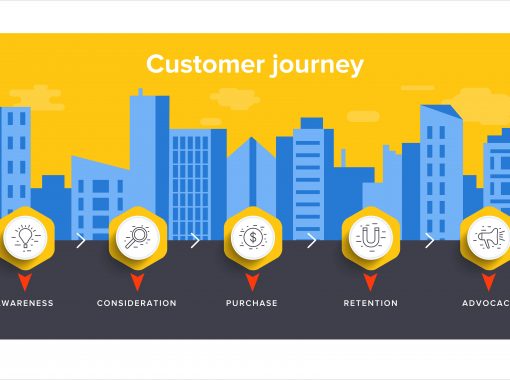
How to Establish a B2B Content Marketing Strategy
A solid content strategy enables you to deliver your message in a consistent way while maximizing resources and business outcomes. For B2B marketers, the roadmap to content success isn’t always straightforward. Therefore, establishing a cohesive B2B content marketing strategy is crucial for driving results.
Let’s dive into the key elements of a successful content marketing strategy.
What Are the Steps To Building a B2B Content Marketing Strategy?
A B2B content marketing strategy is a comprehensive plan that outlines the following:
- What content will be made (content types)
- Why it’s being made (content goals)
- Who it’s for (target audience)
- Where it will be shared (distribution strategy)
- How it will be measured (content KPIs)
Content strategies are not static. They evolve with your business, your audience, and the latest trends. Successful content strategies are also typically not based on one content type. It’s recommended to leverage various formats and platforms to engage your audience at every stage of the buyer’s journey.
Whether you’re strategizing in-house or working with an agency, you must ensure your team is equipped with information about your business, audience, goals, and more. This data can then be used to inform your plans.
The following steps are essential parts of the process of creating a B2B content marketing strategy.
Identifying Content Goals Tied to Business Impact
Content goals are the overarching objectives that drive your content strategy. When establishing content goals, it’s important to consider the business impact you’re looking to make. Examples include the following:
- Educating your audience: This means providing them with the information they need and positioning yourself as an industry thought leader. It builds trust, which supports lead generation and client retention.
- Boosting brand awareness: Letting people know about your brand is important for establishing familiarity. The more people get to know who you are and what you do, the more likely they are to think of your brand when they encounter a problem to which you have the solution.
- Driving organic traffic: As you rank for more search terms, and increase your rankings higher up on the SERP, you increase the likelihood for your content to bring in website visitors.
- Generating leads and conversions: This is likely to be your biggest goal. Your content should attract potential customers and encourage them to convert. Your content is an extension of your website, and the more valuable it is, the more likely people are to click through and take desired actions.
Without a clear objective and goals, you won’t be able to measure the impact of your content strategy. And without measurement, it’s impossible to track what’s working and what isn’t and make necessary changes.
Setting Your Content KPIs From The Start
Once you’ve set your goals, you’re better able to set your key performance indicators (KPIs). These are the metrics you’ll use to track your progress. These are some of the most important content KPIs to consider:
- Website visits: This tells you how much traffic your content is generating.
- Conversion rate: This is the percentage of visitors who take a desired action, like signing up for a newsletter or making a purchase. It gives you a better idea of your content’s effectiveness.
- Social media engagement: Likes, shares, and comments are all indicators that your content has resonated with your audience. Pay attention to which posts perform best and use that information to shape future content.
- Email open rate: If email marketing is part of your strategy, then tracking how many people are opening your emails is important. This will help you determine if your subject lines and content are compelling enough.
Moreover, depending on your goals and the type of content you’re producing, your KPIs may vary. For example:
- If your goal is to increase brand awareness, one of your KPIs may be “number of social media followers.”
- If your goal is lead generation, a KPI could be “number of free trial sign-ups.”
- If you’re looking to generate organic traffic, your KPI could be “website traffic from search engines.”
Make sure you’ve got a combination of short-term and long-term KPIs to track the immediate success of your B2B content marketing strategy and its long-term impact on your business. Without both of these, you won’t be able to tell if your content is actually helping you achieve your business goals.
Understanding Your Target Audience
When it comes to B2B marketing, creating effective content means speaking directly to professionals. Understand your target audience — their needs, preferences, and online behavior. Are your ideal customers looking to learn something new, solve problems, or make their job easier?
Whether they’re working in IT, healthcare, finance, or any other industry, it’s highly likely that your audience is looking for content that speaks to their specific pain points and provides solutions. These pain points will vary depending on their job role, seniority, and other factors. So, it’s important to research your audience and create buyer personas representing them.
When creating buyer personas, include demographics like job title, responsibilities, challenges, goals, and preferred channels for receiving information. Here are a few tips to get you started:
- Explore industry forums or social media groups to identify common questions or challenges your audience faces.
- Survey your audience directly and ask your followers what content they’d like to see more of.
- Speak to your sales and customer service teams to understand what themes come up with current and prospective clients.
- Use Google Analytics or heat mapping tools to understand demographics and site behaviors. Find out where users spend the most time on your site and what content they engage with the most.
All the information you get shapes your content strategy, ensuring it connects and motivates them to take desired actions.
In B2B content marketing, it’s not about reaching the most people — it’s about reaching the right people with the right content.
Choosing the Right Content Types For Your Needs
Once you have a comprehensive understanding of your business goals and target audience, it’s time to choose which content formats and channels will be best for your campaigns and ongoing efforts.
Depending on your industry, the topic, customer personas, and the type of digital channels your audience frequents, certain types of content may be more effective than others. Likewise, different formats are suited for different stages of the buyer’s journey.
For example:
- Blog Posts. Top-of-the-funnel blog posts might focus on broader industry trends or challenges, while bottom-of-the-funnel posts could dive deeper into your products or services and their unique benefits.
- Whitepapers. These are highly valuable for B2B audiences who navigate complex problems. They serve as mid-to-bottom funnel content, demonstrating expertise and providing value to professionals seeking in-depth knowledge on specific topics.
- Case Studies. These real-world examples show how you help your customers overcome challenges or achieve their goals. They’re powerful decision-stage content showcasing your successes and helping potential customers envision what working with you could look like.
Experimentation is a great idea here. Try different types of long-form content, measure their performance, and adjust your B2B content marketing strategy based on what works best with your audience.
Systematizing Your Content Process
Creating consistently high-quality content requires a systematic approach. This means organizing your content production in an efficient, effective, and repeatable way. Here are some steps to help you do that:
- Set up a content calendar. To maximize scalability, consider how you can repurpose content. For example, a whitepaper could be broken down into several blog posts, infographics, or webinars.
- Create style guidelines and templates. Define your brand voice, visual guidelines, and layout templates for different long-form content types and outline how to break them down into new pieces.
- Leverage technology. Use tools like project management software or collaboration platforms to streamline communication between team members and optimization tools to ensure your content is SEO-friendly.
- Consider outsourcing. B2B content takes significant time and expertise to produce. Hiring a content writing agency can streamline the content creation process if you have a lean team but are committed to a robust content strategy.
With a well-organized process, you can work smarter, not harder, and ensure your content is being produced consistently and efficiently, whether in-house or outsourced.
How Do I Distribute My Content?
Now that you know what you’re trying to achieve, who you’re looking to reach, what content types you’re creating, and how you’ll create content, it’s time to talk distribution.
Your audience may frequent different platforms and have unique habits for consuming content. Find out what those are, then align your strategy to ensure you’re reaching them at the right place and the right time.
Here are a few strategies to distribute your content effectively:
- Multi-Channel Marketing: Increase visibility by publishing content on the platforms your audience visits.
- Platform Adaptation: Tailor content to each platform by optimizing the topics and tone of voice for the platform’s specific audience.
- PR Distribution: Use press releases to share important news or product launches. Distribute these to relevant media, bloggers, and influencers.
- Sponsored Content: Pay for your content to be featured on external platforms. Ensure content quality and topics align with the host platform’s audience.
- Partnerships: Collaborate with like-minded, non-competitive businesses or influencers to broaden your content’s reach. This could involve co-creation or guest posting.
- Email Marketing: Engage your subscribers with regular newsletters, exclusive content, or special offers sent directly to their inbox.
- Webinars and Podcasts: Utilize these platforms for a more personal connection. Discuss topics related to your content and distribute these through your channels.
- Live Events: Distribute content at conferences, trade shows, or workshops. This could be in the form of printed materials, digital displays, or presentations.
By connecting with your audience when and where they’re online, you can create an impression that endures long after they’ve finished engaging with your content.
How Frequently Should I Publish Content?
The question of frequency in content publishing often comes down to a balance between quality and quantity. It’s important to publish regularly to keep your audience engaged and your brand top-of-mind. However, equally important is ensuring each content piece is a quality resource for your audience.
The right frequency can also vary by channel. For instance, you might post daily on social media, send a weekly email newsletter, publish bi-weekly blog posts, and release a whitepaper or case study once a quarter.
Begin Building Your B2B Content Marketing Strategy
A winning content strategy begins with a deep understanding of who you are as a company, the goals you want to achieve, and the creativity and insight to meet those goals.
With this in mind, consider outsourcing content marketing to a specialized team that can help you create, repurpose, and distribute your content for maximum impact. With the right approach and consistent effort, your B2B company can ace the content marketing game. Contact ContentWriters to speak with a content strategist today.
Sallie’s natural attraction to things with high impact led to a career in SEO and content marketing. She has worked on many projects in the digital space, working across industries to help brands create meaningful content.




